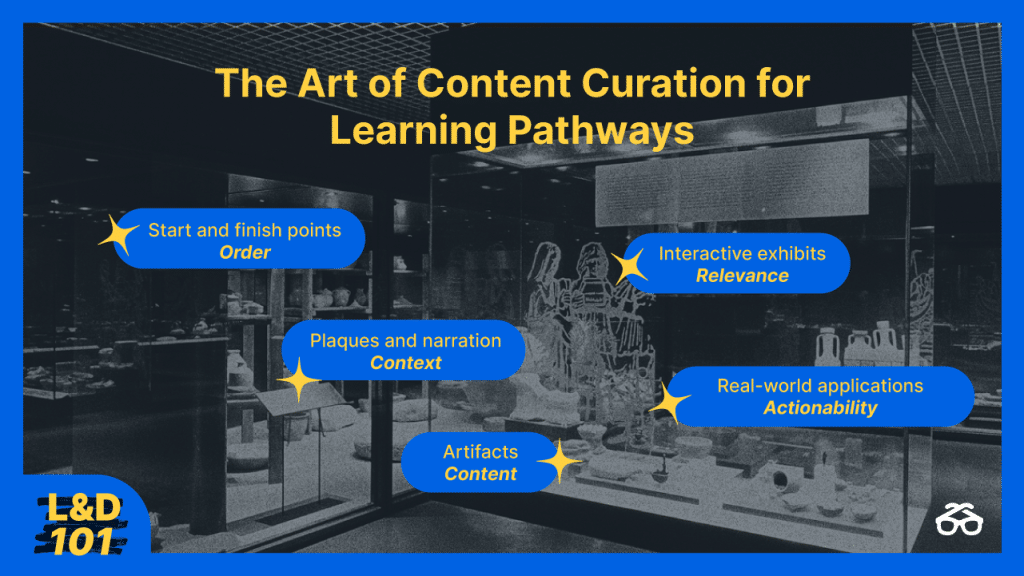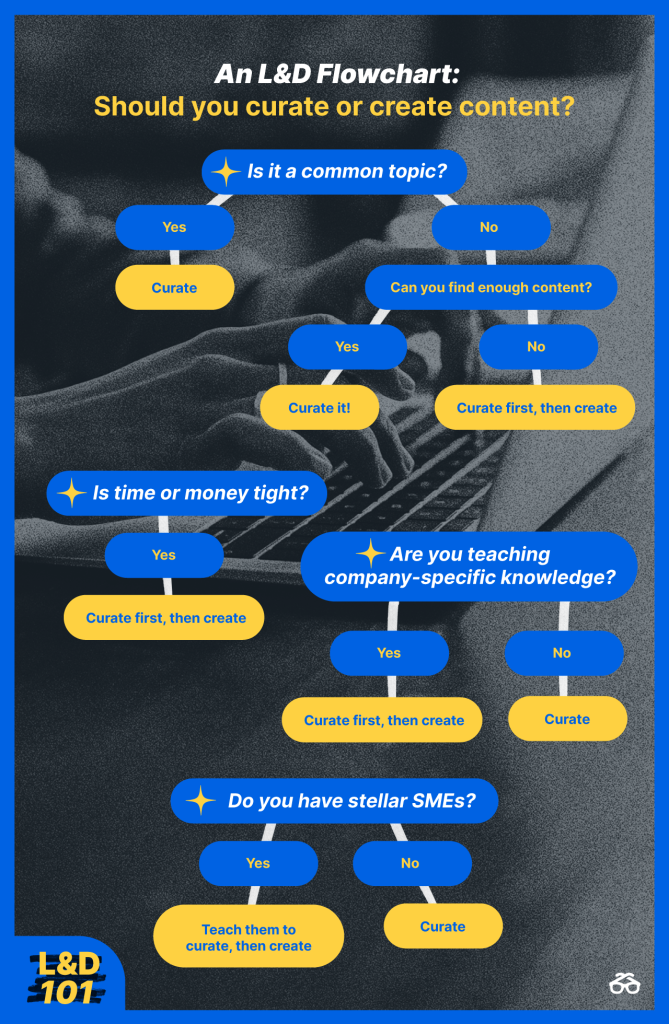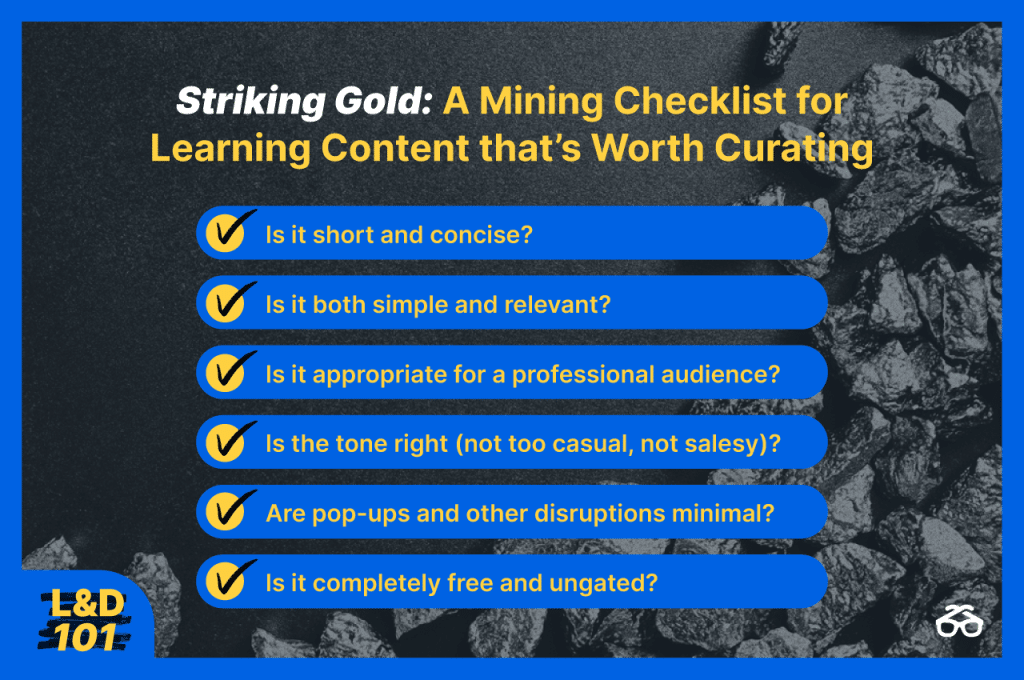Like nearly every other industry on Earth, AI is transforming L&D. According to a 2023 study by Training Magazine, more than one in five L&D teams are investing in generative AI alone. They’re using AI for everything from recommending learning content to content curation to matching learning to skills gaps.
But while AI is making both content curation and creation easier than ever, the role of humans has never been more important. L&D professionals are still the best judges of when to create or curate. And they’re the ones ensuring that content delivers results.
Here’s how to choose between content creation and content curation for learning—and how to do curating well—to ensure you’re maximizing your efforts and ROI.
The Basics: Content Creation vs. Curation
Many companies dismiss content curation for developing learning pathways. They think it’ll be much easier to create exactly what they need rather than try to find the perfect resource in a content database—or, if they’re daring, out in the wilds of the internet. But the opposite is actually true.

What content curation is—and isn’t.
And hey, owning all your learning content and adding company branding to it for good measure? That’s a total boss move. But the truth is, in most cases, curating will get more engaging learning to your employees faster and cheaper than creating. That is, if you do it well.
Think of yourself as a museum curator designing an exhibit. Whether you’re teaching kids about their favorite dinosaurs or adults about their favorite historical figures, you wouldn’t just stick a bunch of artifacts in a room and wish the museum-goer good luck. You’d create an experience. You’d give them a map. And you’d make sure they learned something they could use.
Learning pathways are like museum experiences, and every piece of content is like an artifact on display. Without a well-placed plaque to explain its significance, it doesn’t mean much. Content, like an artifact, needs context. It needs to tell a story with a clear beginning and end. And it needs to be both relevant and actionable—like that water conservation exhibit (complete with tips for xeriscaping my lawn) at my local natural history museum.
Content Creation or Curation: Which should you do?
So which is better: creation or curation? I confess: this is a bit of a trick question, at least when it comes to your overall L&D strategy. You should do both. Default to content curation most of the time, but keep creation in the mix as needed.
When to curate:
- When the topic is common to your industry: There’s a good chance great content already exists, so go find it!
- When time or money is tight: Which is pretty much always, right? Curation is cheaper and faster than creation.
- For rapidly changing industries: Updating curated content is also faster and cheaper than re-creating content from scratch each time the industry changes.
- Before investing in custom content: There’s more learning content on the internet than ever before. Even if your topic seems niche, it’s probably worth a look.
When to create:
- When the topic is super niche or advanced: You might have trouble finding quality, ungated content.
- For company- or department-specific knowledge: Your processes, products, branding, and customers are unique.
- When something is missing: To fill the gap between knowledge and implementation, create content around custom projects and tasks.
- When you have stellar SMEs: Organizations with the best talent are poised to lead content creation in their industry.

Common Curation Pitfalls—and what to do instead.
It’s easy to misstep when curating, even if you’re an L&D veteran. So we asked our in-house experts who work with Degreed clients daily to build programs for tips on avoiding common pitfalls in curating content for learning.
Pitfall 1: Content Overwhelm
With most topics, you’ll find way more content than you can use, and some of it…won’t be great. It can feel overwhelming to sort through the junk to find the gems, so apply some structure to your search.
Best Practice
Use a checklist and chuck anything that doesn’t fit. Here’s a starter list, but adjust it according to your preferences and topic:
- Is it short and concise?
- Is it both simple and relevant?
- Is it appropriate for a professional audience?
- Is the tone right (not too casual, not salesy)?
- Are pop-ups and other disruptions minimal?
- Is it completely free and ungated? (Three free articles per month won’t be enough for many people.)

Pitfall 2: Building Playlists Instead of Pathways
If your courses feel more like playlists than exhibits, the learner is missing out—and so is your organization. Building a playlist is like displaying a museum full of artifacts with no narration.
Best Practice
Consider yourself a docent on this learning journey. Narrate the experience with guidance on how to consume the content, how to use the knowledge, and why it matters. Carefully craft the sequence people should follow, and make that clear. Where should people take breaks?
Draw focus to what’s most valuable in the content. Note any limitations, like what the creator gets wrong and where your company’s practices might differ. Finally, tie concepts to the work and emphasize the benefit to the learner. How can people use what they’ve learned right now?
Pitfall 3: Planning Long, Winding Pathways
I can spend about three hours in my favorite museums before my mind wanders away and begins planning dinner—and most people I know tap out long before.
When you find a lot of great content, it’s tempting to create pathways that are four or six hours long. But long pathways are like long to-do lists: they feel overwhelming until you break them into smaller, more manageable tasks.
Best Practice
Aim for pathways that are 60 to 90 minutes long and break these into three or four sections. Chunk the learning into bite-sized pieces. You’ll wind up with 15-to-20-minute learning sessions, which feel more doable.
Consider chunking even smaller things together to create micro-learning opportunities. A manager can fit a micro-lesson in between calls, while a software developer can knock out multiple micro lessons while their code compiles. The smaller you can chunk out the content, the more learning people will fit into their day.
Pitfall 4: Burying the Good Stuff
Don’t be shy about pointing people to the best parts of a long video or article. The Louvre doesn’t hide the Mona Lisa in a dimly lit basement corner, so don’t hide your gems in a sea of less relevant content.
Best Practice
Point people to the right part of the content and note that the rest is context, optional or unimportant. For videos and podcasts, give them a timestamp. For articles and internal documents, use jump links.
Pitfall 5: Hogging All The Curation Duties
You’re a learning expert, and there are a lot of topics you can curate quite well. But that doesn’t mean you’re the best person to curate everything. Chances are, there are SMEs at your organization who can better spot the best content and provide insightful context that you’d miss.
With a little help from you, SMEs can also be great curators—and help propel your organization toward a skills-first culture.
Best Practice
Ask a SME for help with curating content, and you’ll cook up a great learning pathway. Teach an SME to curate, and they’ll serve up pathway after pathway. If you could upskill just one SME per function to build just one pathway per month, how much would your capacity increase?
Curating a Path Towards a Skills-First Organization
Content curation is faster, cheaper, and easier than creating, but doing it well makes all the difference to the ultimate L&D ROI: a highly skilled workforce that drives your organization forward.
Furthermore, organizations that allocate resources for becoming masterful curators instead of default creators forge best practices that workers with other areas of expertise can adopt. And that’s critical for the future of any skills-first organization. Because skills-first companies are driven by skills-first people.
Having an army of upskilled SMEs upskilling your workforce might feel like a lofty goal. And it is. Few organizations have reached this level of skills-first L&D, but many are on their way. These are the same organizations with robust user-generated content, peer coaching programs, and lean on the Seek, Sense, Share framework of learning.
To learn how to fit content curation into employee upskilling, check out, “The Skills Lifecycle Part 3: Curation is the new Creation.”
